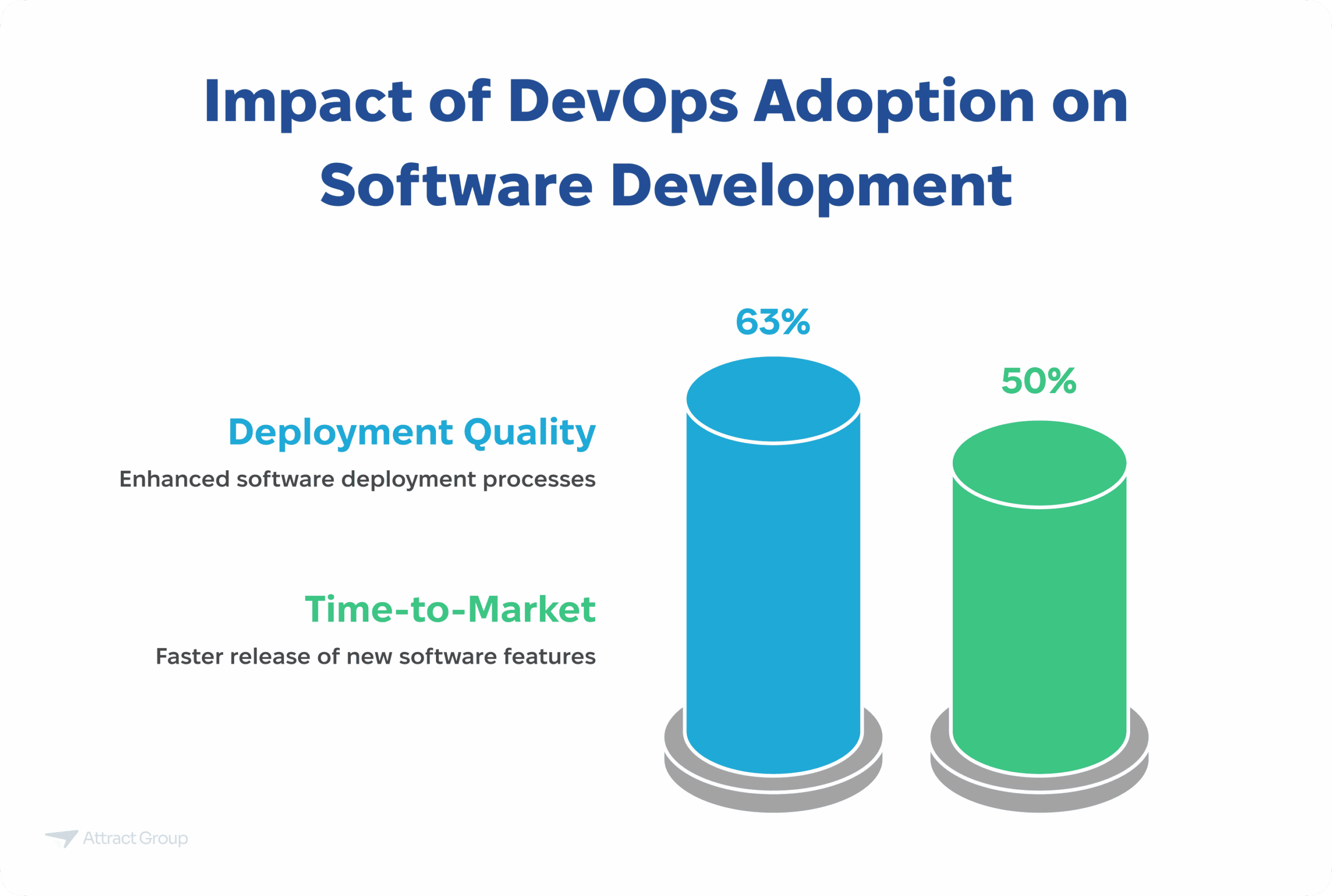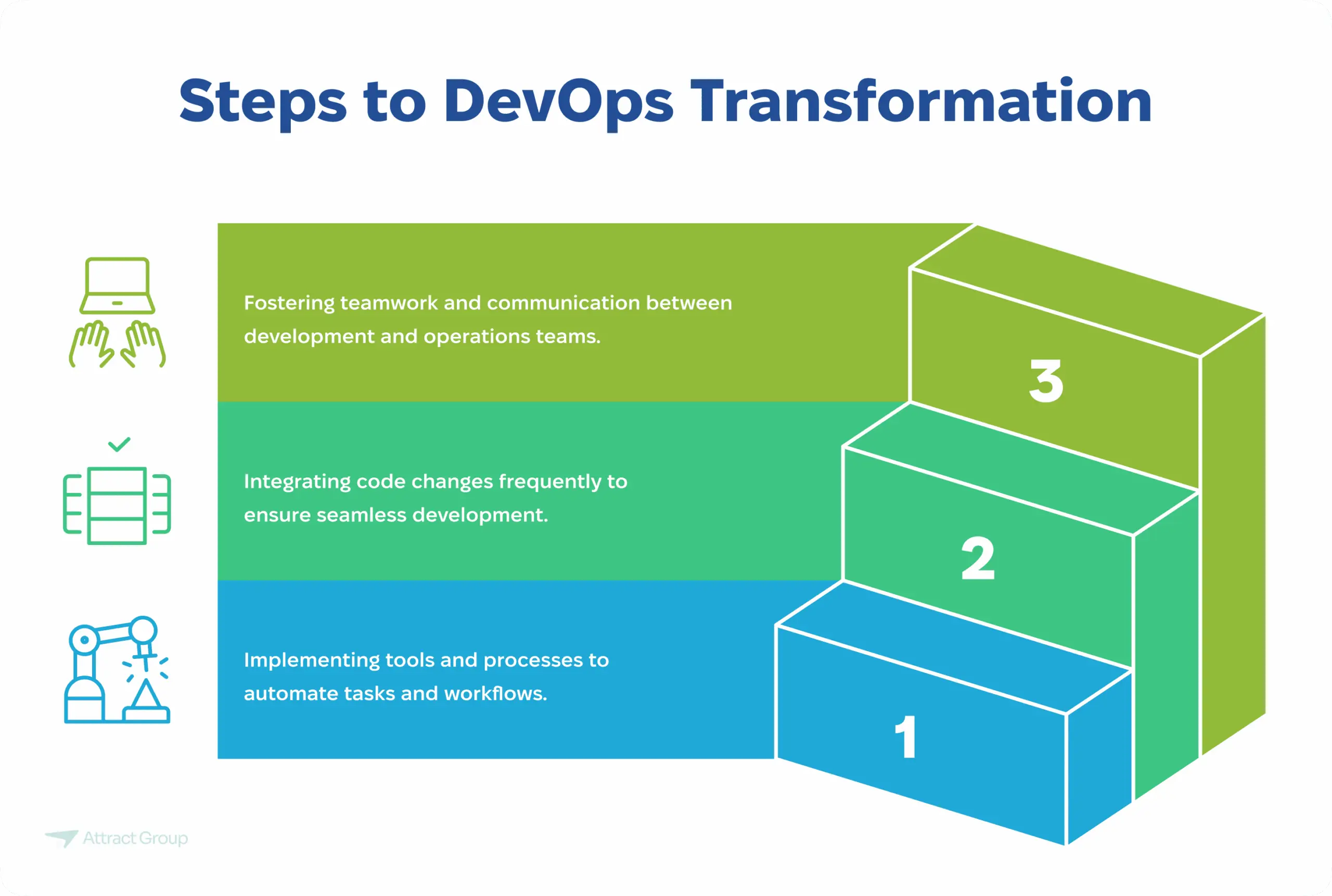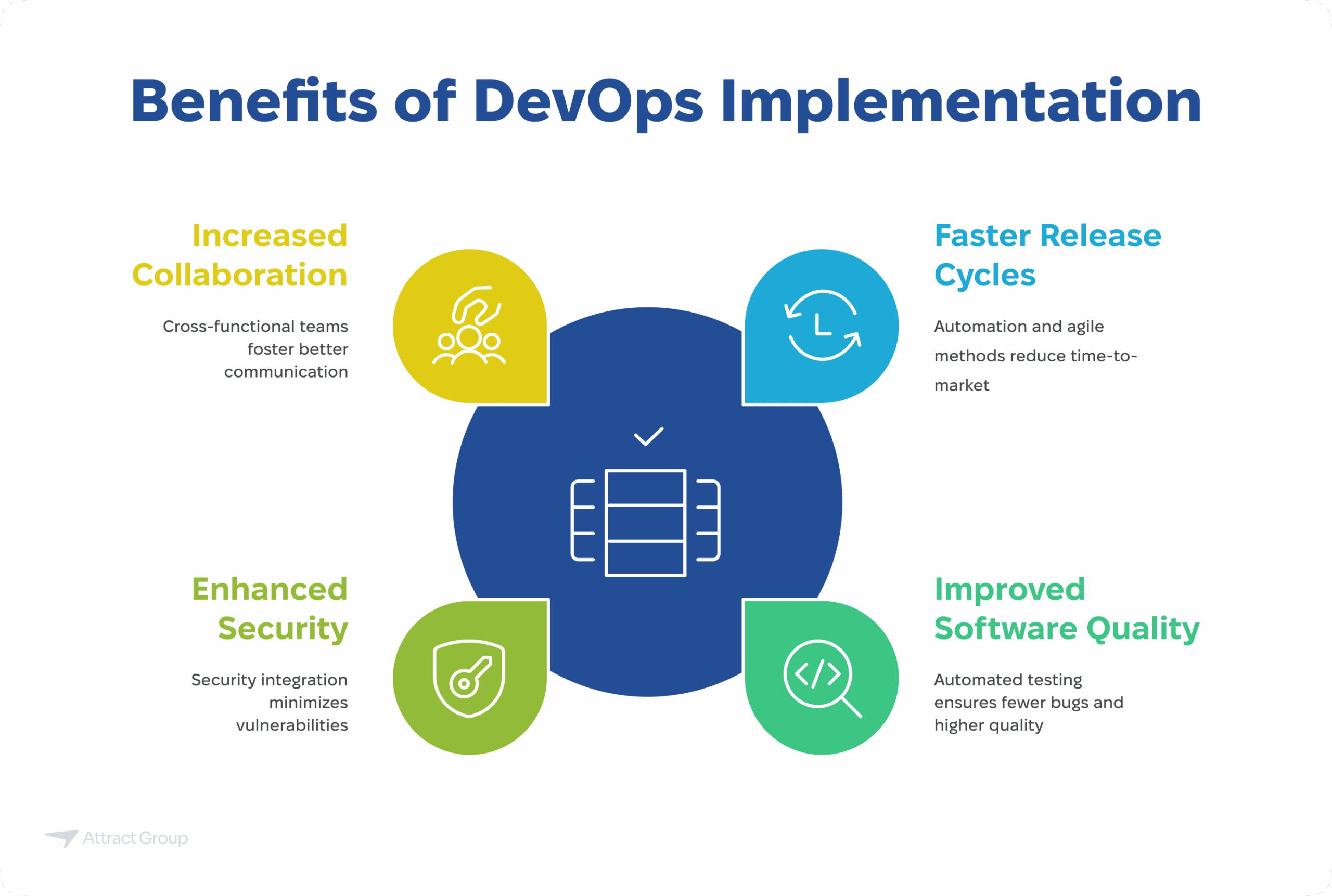DevOps Success Stories: Real-Life Case Studies
 29 July 2024
29 July 2024🔊 Listen to the Summary of this article in Audio
Organizations across various industries have successfully embraced DevOps to streamline their software development, resulting in faster deployment cycles, improved software quality, and increased customer satisfaction. The tangible benefits of DevOps adoption are evident in the significant metrics reported by companies: up to a 63% improvement in deployment quality and a reduction in time-to-market for new features by 50%.

This article aims to explore the transformative power of DevOps through real-life case studies of successful organizations. By delving into their DevOps journey, we will uncover how these companies recognized the need for change, embraced DevOps principles, and reaped substantial benefits from their initiatives.
Highlighting examples from industry leaders such as Capital One, Etsy, and Netflix, we will provide valuable insights into the practical implementation of DevOps practices. Through these stories, readers will learn how these companies have leveraged automation, continuous integration, and agile development to foster innovation and achieve a competitive edge.
Ultimately, the goal of this article is to inspire IT entrepreneurs, business owners, project managers, and startups to consider the adoption of DevOps principles to transform their software delivery processes. By understanding the best practices and outcomes of successful DevOps transformations, organizations can embark on their own journey towards achieving excellence in software development and operations.
The DevOps Journey: From Adoption to Transformation
Recognizing the Need for DevOps
The journey towards successful DevOps adoption often begins with recognizing the need for change. For many organizations, traditional software development and operations models present significant challenges such as slow release cycles, poor collaboration between teams, and frequent deployment failures. These inefficiencies can lead to delayed product launches, decreased customer satisfaction, and a lack of competitive edge in the market.
Take, for example, an organization struggling with lengthy manual deployment processes and siloed teams. The development team writes code and hands it off to the operations team, leading to miscommunications and delays. Additionally, the lack of automated testing means bugs are often discovered late in the development cycle, causing further setbacks and jeopardizing software quality.
Realizing these pain points is the first step toward considering a DevOps transformation. By acknowledging the limitations of their current processes, organizations can set the stage for embracing DevOps practices that promise greater efficiency, agility, and collaboration.
Get a comprehensive assessment of your current software development processes and discover how DevOps can revolutionize your organization
Embracing DevOps Principles
Once the need for change is recognized, the next phase involves embracing DevOps principles. This step is critical as it lays the foundation for a successful DevOps transformation. Key principles include:
Continuous Integration and Continuous Delivery (CI/CD): These practices focus on integrating code changes frequently and delivering them to production rapidly and reliably. Automated testing is a significant component, ensuring that code is consistently tested and validated before deployment.
Agile Development: Agile methodologies promote iterative development, flexibility, and collaboration. By adopting agile principles, organizations can respond more effectively to changing requirements and priorities.
Collaborative Culture: Fostering a culture of collaboration between development and operations teams is essential. Shared goals, transparent communication, and cross-functional teams help break down silos and promote a unified approach to software delivery.
For instance, a company may start by implementing CI/CD pipelines to automate their build, test, and deployment processes. This not only speeds up software delivery but also minimizes the risk of errors and enhances software quality. Simultaneously, they might adopt agile development practices to enable iterative and incremental improvements, ensuring that the product continuously evolves based on user feedback and market trends.
Practical Steps to Implement DevOps
Implementing DevOps requires a structured approach, involving both technological changes and cultural shifts. Here are some practical steps that organizations can take:
- Assess Current Processes: Conduct a thorough assessment of existing software development and deployment processes to identify bottlenecks and areas for improvement.
- Select the Right Tools: Choose DevOps tools that align with your organization’s needs. These may include version control systems (e.g., Git), CI/CD platforms (e.g., Jenkins), containerization tools (e.g., Docker), and infrastructure as code (IaC) tools (e.g., Terraform).
- Build Cross-Functional Teams: Encourage collaboration by creating cross-functional teams that include members from development, operations, quality assurance, and other relevant departments.
- Automate Routine Tasks: Focus on automating repetitive tasks such as code builds, testing, and deployments to increase efficiency and reduce human errors.
- Foster a Culture of Continuous Improvement: Encourage a mindset of continuous learning and improvement. Regularly review processes, incorporate feedback, and make iterative enhancements.
By following these steps, organizations can lay a strong foundation for their DevOps journey and position themselves for a successful transformation.
Our experienced team of DevOps professionals can help you implement best practices, select the right tools, and build a collaborative culture for your organization
Case Study Previews
To illustrate these concepts further, we will explore real-world examples of successful DevOps transformations in the following sections. We’ll dive into how Capital One, Etsy, and Netflix recognized the need for change, implemented DevOps principles, and achieved remarkable results in their software delivery processes. These case studies will provide valuable insights into the practical application of DevOps and demonstrate the tangible benefits of adopting this transformative approach.
Success Story 1: Capital One’s Transformation
Background and Challenges
Capital One, a leading financial institution, realized that to stay competitive and deliver high-quality digital services to its customers, it needed to overhaul its traditional software development and deployment processes. The organization faced several challenges, including:
- Slow Release Cycles: Capital One’s legacy systems and manual processes led to prolonged release cycles, delaying the launch of new features and updates.
- Siloed Teams: The development and operations teams worked in silos, resulting in miscommunication, inefficiencies, and frequent deployment failures.
- Security Concerns: As a financial institution, ensuring robust security and compliance was paramount. The existing processes made it difficult to maintain the stringent security standards required.
Recognizing these challenges, Capital One embarked on a DevOps journey to streamline its software delivery capabilities and foster a more collaborative and agile environment.

DevOps Implementation at Capital One
Capital One’s DevOps transformation involved a comprehensive strategy focused on automation, continuous integration, and fostering collaboration between development and operations teams. Here are the key steps they took:
Automation and CI/CD
- Automated Testing: Capital One implemented automated testing frameworks to ensure that code changes were thoroughly tested before deployment. This reduced the risk of bugs and enhanced software quality.
- Continuous Integration (CI): Developers integrated code changes frequently into a shared repository using CI tools like Jenkins. This practice allowed for early detection of integration issues and ensured that the codebase remained stable.
- Continuous Delivery (CD): Capital One established continuous delivery pipelines, automating the deployment process. This enabled rapid and reliable delivery of new features and updates to production environments.
Agile Development Practices
- Adoption of Agile Methodologies: Capital One adopted agile practices such as Scrum and Kanban to promote iterative development and flexibility. This allowed teams to respond quickly to changing requirements and priorities.
- Cross-Functional Teams: The organization formed cross-functional teams comprising members from development, operations, security, and quality assurance. This fostered collaboration and ensured that all aspects of the software delivery lifecycle were considered.
Emphasis on Security
- DevSecOps: Integrating security into the DevOps pipeline was a priority. Capital One adopted DevSecOps practices to ensure that security checks were automated and integrated into every stage of the CI/CD pipeline. This approach helped maintain compliance and mitigate security risks.
Results and Benefits
Capital One’s DevOps implementation yielded significant improvements in its software delivery capabilities. Here are some of the key benefits they achieved:
- Faster Release Cycles: The automation of testing and deployment processes, along with agile methodologies, reduced the time-to-market for new features by 50%. This enabled Capital One to deliver new digital services to customers more quickly.
- Improved Software Quality: Automated testing and continuous integration ensured that code changes were thoroughly validated, resulting in fewer bugs and higher-quality software releases.
- Enhanced Security: By integrating security into the DevOps pipeline, Capital One maintained robust security standards while accelerating software delivery. This approach minimized vulnerabilities and ensured compliance with industry regulations.
- Increased Collaboration: The formation of cross-functional teams broke down silos, fostering a culture of collaboration and shared responsibility. This led to more efficient workflows and better communication between teams.
Capital One’s successful DevOps transformation demonstrates the power of automation, continuous integration, and collaborative culture in enhancing software delivery capabilities. By recognizing the need for change and embracing DevOps principles, Capital One not only improved its release cycles and software quality but also maintained robust security standards. The organization’s experience serves as an inspiring example for other businesses looking to implement DevOps to drive innovation and achieve a competitive edge in their respective industries.
Success Story 2: Etsy’s Streamlined Software Delivery
Background and Challenges
Etsy, a prominent online marketplace for handmade goods, faced unique challenges in its software development lifecycle. Known for its commitment to providing a seamless user experience to buyers and sellers, Etsy needed to ensure rapid deployment of new features, maintenance of high software quality, and quick resolution of any issues. However, the company struggled with:
- Frequent Downtime: Due to manual deployment processes and lack of automated testing, Etsy experienced frequent downtimes, affecting customer satisfaction.
- Siloed Teams: The development and operations teams operated in silos, which led to communication gaps and inefficient workflows.
- Slow Release Cycles: Prolonged release cycles hindered Etsy’s ability to swiftly introduce new features and updates, impacting the overall user experience.
Recognizing the need to streamline its software development and operations, Etsy embarked on a successful DevOps transformation that embraced cloud-native DevOps practices.

DevOps Practices at Etsy
Etsy’s adoption of DevOps practices marked a significant shift in how the company approached software development and deployment. The transformation involved several strategic initiatives aimed at fostering collaboration and automation between development and operations.
Embracing DevOps Principles
- Commitment to Collaboration: Etsy broke down silos by forming cross-functional teams, encouraging collaboration between developers, operations, and quality assurance. This shift promoted a unified approach to problem-solving and feature development.
- Agile Methodologies: Embracing agile methodologies such as Scrum allowed Etsy to adopt an iterative approach to software development. This ensured flexibility and enabled the team to respond swiftly to market demands and user feedback.
Cloud-Native DevOps and Automation
- Infrastructure as Code (IaC): Etsy implemented IaC practices using tools like Terraform and AWS CloudFormation. This enabled the team to manage infrastructure through code, ensuring consistency and easy reproducibility across environments.
- Continuous Integration (CI) and Continuous Delivery (CD): The company set up CI/CD pipelines using tools like Jenkins and CircleCI. Automated testing, integrated into these pipelines, ensured that code changes were validated early and often, reducing the risk of bugs in production.
- Automated Monitoring and Incident Response: Etsy adopted automated monitoring solutions to promptly detect and address issues. Tools like New Relic and Grafana allowed the team to monitor system health and performance metrics continuously.
Outcomes and Transformation
Etsy’s successful implementation of DevOps practices yielded remarkable improvements across various aspects of their software development lifecycle.
Faster Time-to-Market
- Reduced Release Cycles: Automation in testing and deployment drastically reduced the time required to release new features and updates. This enabled Etsy to introduce innovations more rapidly, maintaining a competitive edge in the online marketplace for handmade goods.
Enhanced Software Quality
- Improved Stability: Automated testing and continuous integration ensured that code quality remained high, significantly reducing the frequency of production issues and downtime.
- Quick Issue Resolution: With automated monitoring in place, Etsy was able to detect and resolve issues quickly, minimizing impact on users and enhancing overall customer satisfaction.
Collaborative DevOps Culture
- Unified Teams: The emphasis on collaboration between development and operations fostered a cohesive working environment. Shared goals and responsibilities led to more effective communication and efficient workflows.
- Continuous Improvement: A culture of continuous improvement was cultivated through regular retrospectives and feedback loops. This allowed Etsy to iteratively enhance its DevOps practices and tools.
Etsy’s journey towards a streamlined software delivery process through the adoption of DevOps serves as an exemplary instance of how embracing DevOps principles can transform operations in the world of e-commerce. By leveraging cloud-native DevOps approaches, automation, and fostering collaboration between development and operations, Etsy harnessed the power of DevOps to improve its software quality, reduce downtime, and accelerate time-to-market for new features. Other organizations, especially within the online marketplace sector, can draw valuable lessons from Etsy’s commitment to DevOps excellence and continuous integration to drive their own innovation and success.
Success Story 3: Netflix DevOps Practices Implementation
Background and Challenges
Netflix, a leader in the streaming service industry, recognized early on that staying ahead of the competition required continuous innovation and seamless delivery of high-quality content. The company faced several challenges that necessitated a shift towards DevOps:
- High Demand for New Features: With a massive user base, Netflix needed to release new features and updates rapidly to keep viewers engaged.
- Scalability Issues: The traditional methods of deployment struggled to keep up with Netflix’s rapid growth and the increasing demand for its services.
- Operational Complexity: Managing a vast infrastructure with high availability requirements was challenging, especially as Netflix expanded globally.
To address these challenges, Netflix embarked on a successful DevOps transformation to enhance its software delivery capabilities and improve customer experience.
Netflix’s DevOps Approach
Netflix’s DevOps journey focused on leveraging cloud-native DevOps practices, automation, and a culture of continuous improvement. Here are the key aspects of their approach:
Cloud-Native DevOps and Microservices
- Microservices Architecture: Netflix adopted a microservices architecture, breaking down its monolithic application into smaller, independent services. This allowed for more efficient scaling and easier management of individual components.
- Cloud Infrastructure: Moving to a cloud-based infrastructure on Amazon Web Services (AWS) enabled Netflix to achieve high scalability, availability, and resilience. This cloud-native DevOps approach ensured that Netflix could meet the demands of its growing user base.
Automation and Continuous Integration
- Automated Testing and Deployment: Netflix implemented CI/CD pipelines that automated the build, test, and deployment processes. Tools like Spinnaker were used to manage continuous delivery, ensuring that new features could be safely and quickly deployed to production.
- Automated Monitoring and Self-Healing Systems: Netflix developed sophisticated monitoring tools like the Simian Army, which included services such as Chaos Monkey. These tools introduced controlled failures into the system to test resilience and ensure that automated self-healing mechanisms were effective.
Emphasis on Collaboration and Innovation
- Cross-Functional Teams: By fostering collaboration between development, operations, and quality assurance teams, Netflix created a unified environment focused on delivering high-quality software efficiently.
- Culture of Experimentation: Netflix encouraged a culture of experimentation and learning. Developers were empowered to innovate and test new ideas, contributing to the continuous improvement of their services.
Success Metrics and Impact
Netflix’s commitment to DevOps principles and practices resulted in several tangible benefits:
Faster Time-to-Market
- Rapid Deployment: The automation of testing and deployment processes significantly reduced the time required to release new features. This allowed Netflix to continuously introduce new functionalities and stay ahead in the competitive streaming market.
Improved Software Quality and Stability
- Resilience and High Availability: By utilizing cloud-native infrastructure and automated self-healing systems, Netflix ensured high availability and minimized downtime. The use of chaos engineering practices verified the robustness of their systems.
- Enhanced User Experience: Frequent releases of new features and updates, combined with high software quality, resulted in an improved user experience and increased customer satisfaction.
Innovation and Competitive Edge
- Continuous Innovation: The emphasis on a culture of experimentation and continuous improvement allowed Netflix to innovate rapidly. This kept the platform engaging for users and helped maintain their leadership position in the industry.
- Scalability: The adoption of microservices and cloud-native DevOps approaches enabled Netflix to scale its infrastructure efficiently, accommodating growth and expanding its global reach.
Netflix’s successful implementation of DevOps demonstrates the transformative power of embracing cloud-native DevOps practices, automation, and a culture of collaboration. By adopting a microservices architecture, automating testing and deployment, and fostering continuous innovation, Netflix significantly improved its software delivery capabilities, enhanced user experience, and maintained a competitive edge in the streaming industry. Other organizations can learn from Netflix’s dedication to DevOps excellence, leveraging these practices to drive innovation and achieve similar success in their respective fields.
Ready to achieve faster deployments, improved quality, and increased innovation? Our expert developers can tailor a DevOps solution to meet your unique business needs
Conclusion
The successful DevOps transformations of Capital One, Etsy, and Netflix offer valuable lessons for IT entrepreneurs, business owners, project managers, and startups. By recognizing the need for change and embracing DevOps principles, any organization can achieve similar success in their software delivery processes. Here are some steps to get started on your own DevOps journey:
- Assess Your Current State: Identify the pain points and inefficiencies in your current software development and deployment processes. Recognize the need for change as the first step towards transformation.
- Embrace Collaboration: Foster a culture of collaboration between development and operations teams. Break down silos and promote cross-functional team structures.
- Invest in Automation: Implement CI/CD pipelines to automate testing, deployment, and monitoring processes. Choose the right tools that align with your organization’s needs.
- Adopt Agile Practices: Embrace agile methodologies to enable iterative development and continuous improvement. Encourage regular feedback loops to drive innovation.
- Leverage Cloud-Native Solutions: Consider cloud platforms for scalable and flexible infrastructure management. Explore microservices architecture for independent scaling of services.
By following these steps and drawing inspiration from the real-world examples provided in this article, your organization can embark on a successful DevOps journey. Harness the power of DevOps to improve your software quality, accelerate time-to-market for new features, and maintain a competitive edge in your industry. The commitment to continuous improvement and collaboration will drive innovation and ultimately enhance customer satisfaction.









